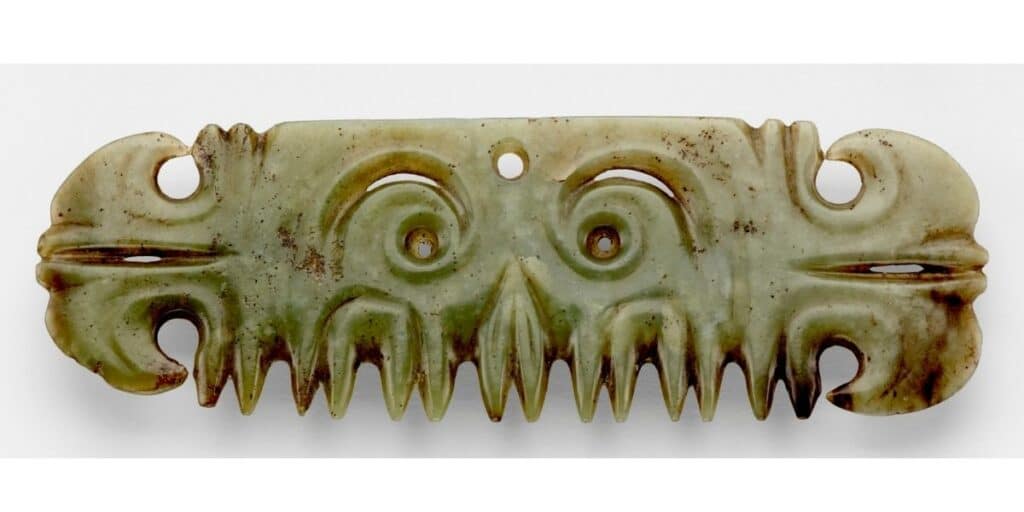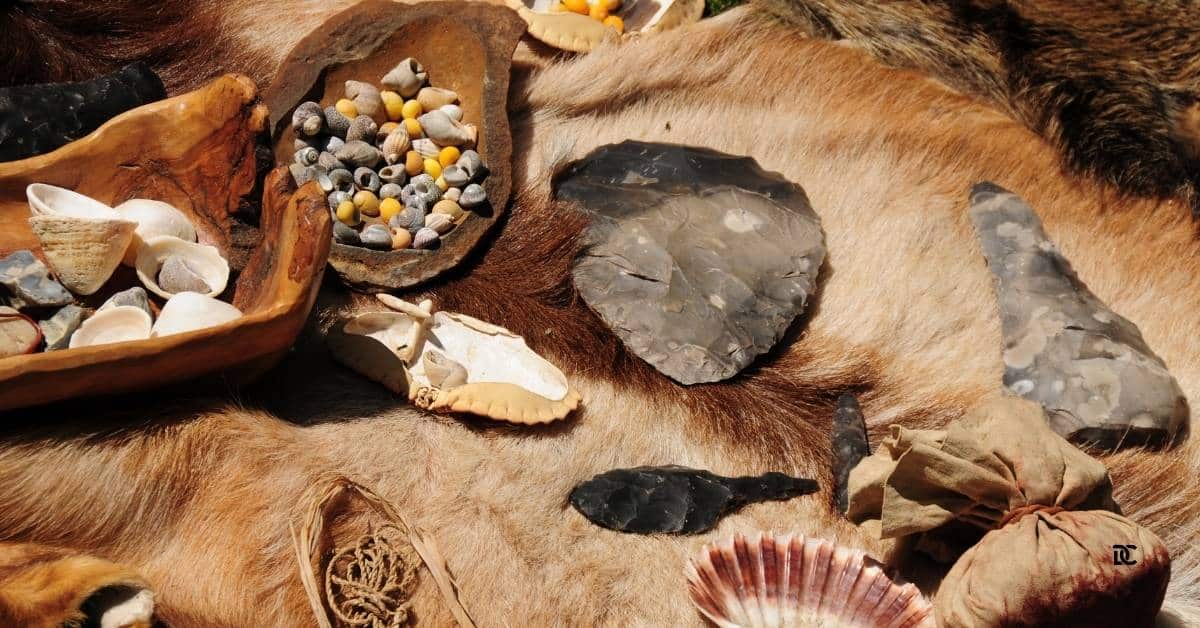The Neolithic period marks an important turning point in the development of Chinese civilization, as recognizable cultural communities developed. This period marks the transition from nomadic hunter-gatherer societies to settled agricultural communities in China.
The Neolithic period in China comes immediately before the establishment of the Xia dynasty in the 21st Century BC. It began around 12,000 BC, but good evidence of settlements from this period only dates back to between 6,000 and 4,000 BC. While hunter-gathererathering was still being practiced across the China area, this age was characterized by the spread of settled agricultural communities, which can be categorized into two distinct cultural groups by the distinct styles of pottery that have been found.
Just like in other parts of the world, people built settlements during the Neolithic period along the major river systems. The main rivers in China are the Yellow River in central and northern China, and the Yangtze River in southern and eastern China.
Yangshao Culture (c. 5000–3000 BCE)
- Location: Central Plain, particularly along the Yellow River.
- Highlights:
- Pottery: Known for distinctive painted pottery featuring geometric patterns and bright colors.
- Agriculture: Early cultivation of millet, which became a staple crop.
- Housing: Built semi-subterranean houses with thatched roofs.
- Social Structure: Evidence of organized communities and possible social stratification.
Over a thousand Yangshao culture sites have been found, primarily at Jianzhai in the Shanxi Province and the Banpo site in Xian. Shanxi is regarded as the center of the Yangshao culture because the majority of the sites are found in this region. As pottery was one of the major cultural advances of this era, it is by pottery discoveries that much of the information about the culture is known. Hand-made red pottery has been found including items such as cooking vessels, bowels cups and jars.
Also Read
The culture was centered on agriculture; crops included millet and chestnuts, and pigs and dogs were raised as livestock. Tools were mainly used for grinding, but stone axes, arrows, and harpoons were commonly used.
Longshan Culture (c. 3000–1900 BCE)
- Location: Along the lower Yellow River, extending into the Yangtze River basin.
- Highlights:
- Advanced Pottery: More refined and often black-painted pottery, including wheel-thrown ceramics.
- Bronze Tools: Introduction of early bronze tools and weapons.
- Urbanization: Development of larger, more complex settlements with defensive walls.
- Burial Practices: Elaborate burials indicating social hierarchy and possibly early state formation.
The Longshan culture was more advanced than the Yangshao culture in several ways. The Longshan used implements made of both stone and copper and their tools included stone knives used to drill holes, as well as stone reaping hooks and shovels. Pottery techniques had also improved and larger quantities of pottery were made while maintaining the quality of the work. Their building style was characterised by rectangular earth-platform buildings using a technique called “rammed earth”.
Hemudu Culture (c. 5000–4500 BCE)
- Location: Along the lower Yangtze River in present-day Zhejiang Province.
- Highlights:
- Rice Cultivation: One of the earliest known centers for rice farming.
- Wooden Structures: Built houses on stilts to protect against flooding.
- Textiles and Fishing: Evidence of textile production and advanced fishing techniques.
The Hemudu Culture (circa 5000–4500 BCE) was a prominent Neolithic civilization located along the lower Yangtze River in present-day Zhejiang Province, China. This culture is especially notable for its early development of rice cultivation, which laid the groundwork for settled agricultural communities in the region.
The Hemudu people constructed houses on stilts to protect against frequent flooding, showcasing their advanced architectural skills.
They were also skilled in textile production and developed sophisticated fishing techniques, indicating a versatile and resourceful society. Additionally, the Hemudu Culture produced intricate pottery and carved wooden artifacts, reflecting their artistic and technological achievements.
This culture played a crucial role in the advancement of early Chinese civilization, contributing significantly to agricultural practices, social organization, and technological innovations that influenced subsequent societies.
Majiayao Culture (c. 3300–2000 BCE)
- Location: Northwestern China, particularly in Gansu and Ningxia provinces.
- Highlights:
- Pottery: Brightly painted pottery with intricate designs, often depicting animals and human figures.
- Agriculture and Animal Husbandry: Cultivation of millet and domestication of pigs and dogs.
- Social Organization: Larger settlements indicate increased social complexity.
The Majiayao Culture was a prominent Neolithic civilization located in northwestern China, particularly in the Gansu and Ningxia provinces. This culture is best known for its brightly painted pottery, which features intricate geometric patterns, animal motifs, and human figures. These vibrant ceramics are considered some of the earliest and most sophisticated examples of pottery art in China.
The Majiayao people were advanced in agriculture and animal husbandry. They cultivated millet as a staple crop and domesticated animals such as pigs and dogs, which supported their settled farming communities. The development of these agricultural practices allowed for the growth of larger, more complex settlements, indicating an increase in social organization and community structure.
They also demonstrated significant technological innovations. They crafted tools from stone and bone, which were used for farming, hunting, and daily activities. Evidence of early weaving and textile production has been found, showcasing their ability to create fabrics and garments.
Social Structure and Community Life
It was during the Neolithic period that the people began to form clans – communities of people linked by family ties – around a totem which was usually an animal or a plant. These clans shared the fruit of their labours equally under the supervision of a leader. Marriages at this stage became monogamous with strict stipulations including the prohibition of younger people marrying their elders and cousins were not allowed to marry.

Archaeological Discoveries
- Yangshao Sites:
- Banpo Village: One of the most famous Yangshao sites, showcasing well-preserved houses, pottery, and artifacts.
- Longshan Sites:
- Longshan Site in Shandong: Reveals fortified walls, black pottery, and early bronze items.
- Hemudu Sites:
- Hemudu Site: Highlights rice paddies, stilt houses, and diverse artifacts, indicating a rich agricultural society.
- Majiayao Sites:
- Majiayao Site in Gansu: Features colorful pottery, large communal structures, and evidence of animal domestication.
Impact on Later Chinese Civilization
- Foundation for Dynastic China: The agricultural surplus and settled communities of the Neolithic period laid the groundwork for the emergence of dynastic rule and complex state structures in later periods.
- Cultural Continuity: Many cultural practices, such as pottery-making techniques and agricultural methods, persisted and evolved through subsequent dynasties.
- Technological Legacy: Innovations in tool-making, agriculture, and architecture from the Neolithic period influenced the technological advancements of ancient China.
The Neolithic period marks the beginning of the development of Chinese culture – the birth of civilization.






